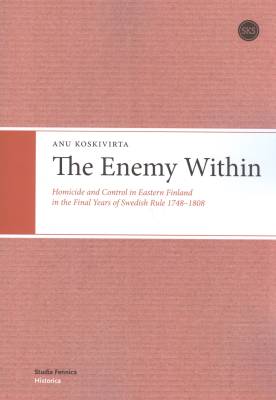The Enemy Within — Homicide and Control in Eastern Finland in the Final Years of Swedish Rule 1748-1808
Koskivirta, AnuTuotetiedot
| Nimeke: | The Enemy Within — Homicide and Control in Eastern Finland in the Final Years of Swedish Rule 1748-1808 | ||
| Tekijät: | Koskivirta, Anu (Kirjoittaja) | ||
| Tuotetunnus: | 9789517464741 | ||
| Tuotemuoto: | Pehmeäkantinen kirja | ||
| Saatavuus: | Toimitusaika 7-14 arkipäivää | ||
| Hinta: | 45,00 € (39,65 € alv 0 %) | ||
|
|||
| Kust. tuotetunnus: | 1369450 |
| Kustantaja: | Suomalaisen Kirjallisuuden Seura |
| Sarja: | Studia Fennica Historica 5 |
| Painos: | 1. painos, 2003 |
| Kieli: | englanti |
| Sivumäärä: | 217 |
| Tuoteryhmät: | Historia Studia Fennica Historica Books in English |
| Kirjastoluokka: | 92.5 Suomen historia, vapauden aika ja kustavilainen aika |
| YSO - Yleinen suomalainen asiasanasto: | rikokset, henkirikokset, murha, tappo, väkivaltarikokset, rikollisuus, kontrollipolitiikka, sosiaalinen kontrolli, Ruotsin vallan aika, oikeushistoria, rikosoikeus, rikosprosessi, oikeudenkäynti, tuomiot, rangaistukset, armahdus, rikoksentorjunta, rikoksentekijät, historiallinen kriminologia, historia, rajaseudut |
| Avainsanat: | Control policy, Crimes, Homicides, Murder, social control |
This work explores the quantitative and qualitative development of homicide in eastern Finland in the second half of the eighteenth century and the early years of the nineteenth. The area studied comprised northern Savo and northern Karelia in eastern Finland. At that time, these were completely agricultural regions on the periphery of the kingdom of Sweden. Indeed the majority of the population still got their living from burn-beating agriculture.
The analysis of homicide there reveals characteristics that were exceptional by Western European standards: the large proportion of premeditated homicides (murders) and those within the family is more reminiscent of modern cities in the West than of a pre-modern rural society. However, there also existed some archaic forms of Western crime there. Most of the homicides within the family were killings of brothers or brothers-in law, connected with the family structure (the extended family) that prevailed in the region. This study uses case analysis to explore the causes for the increase in both familial homicide and murder in the area.
One of the explanatory factors that is dealt with is the interaction between the faltering penal practice that then existed and the increase in certain types of homicide.Despite the fact that it focuses on a particular region, the study and the questions it poses have both international and current relevance. This work builds a bridge between research into legal history and the sociologically oriented study of the history of criminality.
The analysis of homicide there reveals characteristics that were exceptional by Western European standards: the large proportion of premeditated homicides (murders) and those within the family is more reminiscent of modern cities in the West than of a pre-modern rural society. However, there also existed some archaic forms of Western crime there. Most of the homicides within the family were killings of brothers or brothers-in law, connected with the family structure (the extended family) that prevailed in the region. This study uses case analysis to explore the causes for the increase in both familial homicide and murder in the area.
One of the explanatory factors that is dealt with is the interaction between the faltering penal practice that then existed and the increase in certain types of homicide.Despite the fact that it focuses on a particular region, the study and the questions it poses have both international and current relevance. This work builds a bridge between research into legal history and the sociologically oriented study of the history of criminality.





